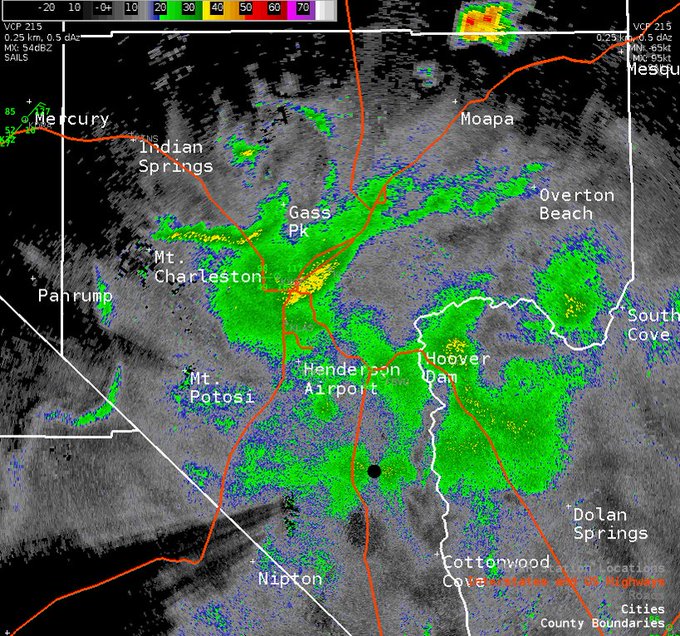By Chaffin Mitchell, AccuWeather staff writer
Residents across Las Vegas, Nevada spotted something unusual moving on Doppler radar on Thursday and Friday evening. The National Weather Service (NWS) office in Las Vegas posted a tweet telling people they were actually seeing a group of grasshoppers, also known as a cloud.
Many things have been spotted on radar such as birds, bats, butterflies, grasshoppers and other bugs; however, sometimes it takes an expert to know the difference between weather and animals.

"Not every radar return is rain," AccuWeather
The satellite image given has stronger returns, as made clear by the brighter colors, but the correlation coefficient is low, meaning the objects look irregular and not like rain.
"Some of you have been asking about the widespread radar returns the past few nights in Vegas. Radar analysis suggests most of these echoes are biological targets," NWS Las Vegas said in a tweet on Saturday morning.
Some of you have been asking about the widespread radar returns the past few nights in #Vegas. Radar analysis suggests most of these echoes are biological targets. This typically includes birds, bats, and bugs, and most likely in our case--> Grasshoppers.
#VegasWeather
364 people are talking about this
An unusual wet season during the first part of 2019 is to be blamed for the large group of grasshoppers, also known as a cloud, to be seen on radar imagery.
"During unusually wet seasons, a species of grasshopper indigenous to the deserts of the Southwest U.S. called the pallid-winged grasshopper tends to be much higher in number and they tend to migrate during this time of year," Strait said.
According to Strait, Las Vegas had more than twice the normal amount of rainfall from January 1 through June 30.
"They have been swarming northward through southern Nevada in recent days and will be around that area in large numbers for the next one to two weeks," Strait said.
"Last night, thunderstorms passing by well north of Las Vegas sent their outflow into the city as they decayed. This churned up the atmosphere a bit and brought more of the grasshoppers high enough in the air to be picked up by the radar beam," Strait said.
According to AccuWeather Meteorologists, radars work by sending out a pulse of energy into the atmosphere. Once the pulse of energy encounters something, like a raindrop, it bounces back.
Larger objects cause more energy to bounce back to the radar; so when swarms of animals are big enough, they are able to show up on weather radar, Strait said.
The chances of picking up animals on the radar are higher when the weather in the area is dry.
"Weather radar today has the capability to tell whether or not the returns it detects is a meteorological target such as a raindrop or snowflake or hailstone or whether it’s not meteorological in nature, such as a swarm of insects or birds, or even tornado debris," Strait said.
RELATED:
Heat to break in California with the Southwest Monsoon returning midweek
Dueling meteor showers to peak Monday night, up to 25 meteors per hour possible
Building heat could challenge record high temperatures over interior California this weekend
So much of the Arctic is on fire you can see it from space
Heat to break in California with the Southwest Monsoon returning midweek
Dueling meteor showers to peak Monday night, up to 25 meteors per hour possible
Building heat could challenge record high temperatures over interior California this weekend
So much of the Arctic is on fire you can see it from space
"This improvement came in 2013 to 2014 when the weather radar network was upgraded to dual polarization technology," Strait said.







No comments:
Post a Comment